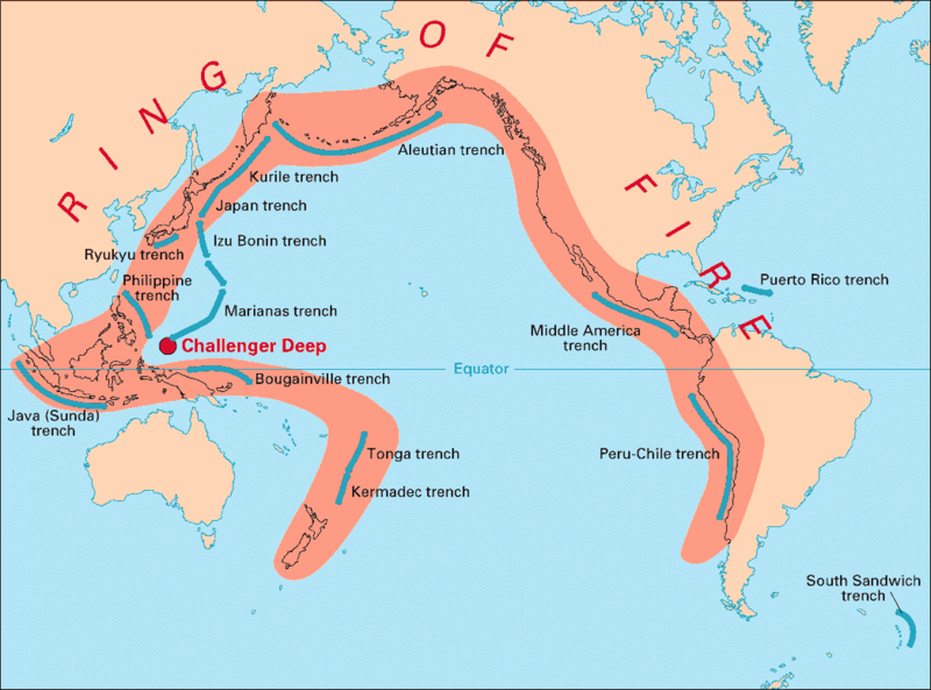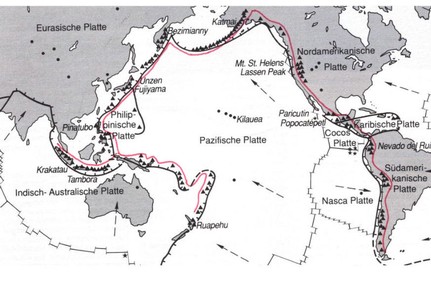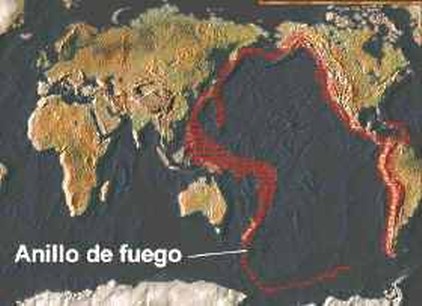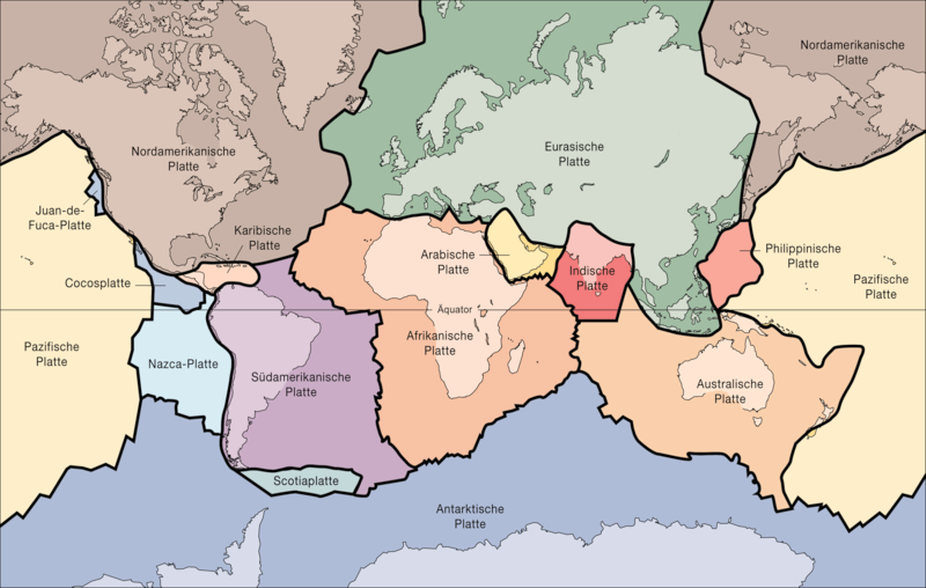Ring of Fire / Tectonic - Rainbowanchorstone
Main menu:
- Rainbowanchorstone
- Introduction
-
Prophecies
- William Marrion Branham
- FGBMFI
- Joe Brandt - The Dream
- Science
- Treasuremap
- More...
Ring of Fire / Tectonic
Science
Something that you should know, if you live in California...

Pacific Ring of Fire
The
Pacific Ring of Fire is an area of frequent earthquakes and volcanic
eruptions encircling the basin of the Pacific Ocean. In a 40,000 km
horseshoe shape, it is associated with a nearly continuous series of
oceanic trenches, volcanic arcs, and volcanic belts and/or plate
movements. The Ring of Fire has 452 volcanoes and is home to over 75% of
the world's active and dormant volcanoes. It is sometimes called the
circum-Pacific belt or the circum-Pacific seismic belt. Ninety percent
of the world's earthquakes and 81% of the world's largest earthquakes
occur along the Ring of Fire. The next most seismic region (5–6% of
earthquakes and 17% of the world's largest earthquakes) is the Alpide
belt which extends from Java to Sumatra through the Himalayas, the
Mediterranean, and out into the Atlantic. The Mid-Atlantic Ridge is the
third most prominent earthquake belt. The Ring of Fire is a direct
result and consequence of plate tectonics and the movement and
collisions of crustal plates. The eastern section of the ring is the
result of the Nazca Plate and the Cocos Plate being subducted beneath
the westward moving South American Plate. A portion of the Pacific Plate
along with the small Juan de Fuca Plate are being subducted beneath the
North American Plate. Along the northern portion the northwestward
moving Pacific plate is being subducted beneath the Aleutian Islands
arc. Further west the Pacific plate is being subducted along the
Kamchatka Peninsula arcs on south past Japan. The southern portion is
more complex with a number of smaller tectonic plates in collision with
the Pacific plate from the Mariana Islands, the Philippines,
Bougainville, Tonga, and New Zealand. Indonesia lies between the Ring of
Fire along the northeastern islands adjacent to and including New
Guinea and the Alpide belt along the south and west from Sumatra, Java,
Bali, Flores, and Timor. The famous and very active San Andreas Fault
zone of California is a transform fault which offsets a portion of the
East Pacific Rise under southwestern United States and Mexico. The
motion of the fault generates numerous small earthquakes, at multiple
times a day, most of which are too small to be felt. The active Queen
Charlotte Fault is a transform fault on the west coast of the Queen
Charlotte Islands, British Columbia, Canada. It has generated three
large earthquakes during the 20th century: a magnitude 7 event in 1929, a
magnitude 8.1 occurred in 1949 (Canada's largest recorded earthquake)
and a magnitude 7.4 in 1970. The December 2004 earthquake just off the
coast of Sumatra was actually a part of the Alpide belt...
source: http://en.wikipedia.org/wiki/Pacific_Ring_of_Fire
Cinturón de Fuego del Pacífico
El
Cinturón de Fuego ubicado en el Océano Pacífico abarca las costas de
Chile, Perú, Ecuador, Colombia, Venezuela, todos los países
centroamericanos, México, los Estados Unidos, Canadá, luego dobla a la
altura de las Islas Aleutianas y baja por las costas de China y Japón. A
su vez, el Océano Pacífico tiene diferentes placas oceánicas que están
en constante fricción y producen acumulación de tensión. En un momento
dado, esa tensión se libera y origina terremotos en los países
mencionados; Además, concentra una actividad volcánica constante sobre
todo en América Central...
Fuente: http://es.wikipedia.org/wiki/Cintur%C3%B3n_de_Fuego_del_Pac%C3%ADfico
Pazifischer Feuerring
Unter dem Pazifischen Feuerring (auch zirkumpazifischer Feuerring oder Feuergürtel) versteht man einen Vulkangürtel, der den Pazifischen Ozean umgibt. Der Pazifische Feuerring besteht größtenteils aus einer Reihe von Inselbögen, wie z. B. den Aleuten, den Kurilen oder den japanischen Ryūkyū-Inseln. Allein auf die westpazifischen Inselbögen entfallen 45% aller Vulkane der Erde. Sie setzen sich fort über die Marianen, die Philippinen, Neuguinea, die Salomonen und die Neuen Hebriden. Der Vulkangürtel setzt sich an den Westrändern Nord- und Südamerikas fort, und bezieht auch die Antarktis ein (vgl. Mount Erebus). An der Westküste Amerikas spielen sich rund 17% aller weltweiten vulkanischen Vorgänge ab. Diese Linie reger Vulkantätigkeit umspannt nahezu die gesamte Pazifische Platte, an deren umlaufendem Rand durch Plattentektonik Subduktionsvorgänge initiiert werden, die Schwächezonen in der Lithosphäre erzeugen, so dass der Aufstieg von flüssigem Magma begünstigt wird...
Quelle: http://de.wikipedia.org/wiki/Pazifischer_Feuerring


Plate tectonics
Plate
tectonics (from Greek τέκτων, tektō?n "builder" or "mason") is a theory
of geology that has been developed to explain the observed evidence for
large scale motions of the Earth's lithosphere. The theory encompassed
and superseded the older theory of continental drift from the first half
of the 20th century and the concept of seafloor spreading developed
during the 1960s. The outermost part of the Earth's interior is made up
of two layers: above is the lithosphere, comprising the crust and the
rigid uppermost part of the mantle. Below the lithosphere lies the
asthenosphere. Although solid, the asthenosphere has relatively low
viscosity and shear strength and can flow like a liquid on geological
time scales. The deeper mantle below the asthenosphere is more rigid
again. This is, however, not due to cooler temperatures but due to high
pressure...
source: http://en.wikipedia.org/wiki/Plate_tectonics
Tectónica de placas
Las
Placas tectonicas (del griego "el que construye" τεκτων, tekton) es una
teoría geológica que explica la forma en que está formada la litósfera
(la porción superior más fría y rígida de la Tierra). La teoría da una
explicación a las placas que forman la superficie de la Tierra y a los
desplazamientos que se observan entre ellas en su desplazamiento sobre
el manto terrestre fluido. Esta teoría también describe el movimiento de
las placas, sus direcciones e interacciones...
Fuente: http://es.wikipedia.org/wiki/Tect%C3%B3nica_de_placas
Plattentektonik
Die Plattentektonik ist die zentrale Theorie für die großräumigen Abläufe in der Erdkruste und im obersten Teil des Erdmantels in der Geologie und Geophysik. Sie kann als an der Erdoberfläche auftretender Ausdruck der Mantelkonvektion im Erdinneren aufgefasst werden und beschreibt die Bewegungen der Lithosphärenplatten – die so genannte Kontinentalverschiebung – und die daraus resultierenden Erscheinungen...
Quelle: http://de.wikipedia.org/wiki/Plattentektonik

If
you type the Keywords, Tectonicle Plates, Ring of Fire, Earthquakes or
San Andreas Fault
or something like that in searchrobots like Google,
Yahoo, Fireball..., you´ll find interesting Reports!
http://www.enchantedlearning.com/subjects/volcano/ringoffire/
http://www.crystalinks.com/rof.html